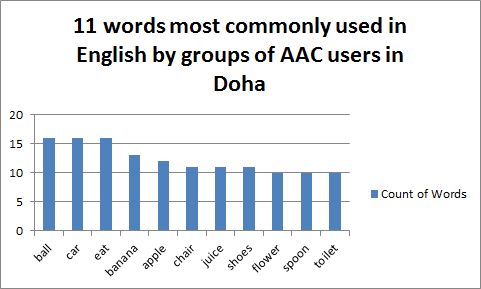 Over the past month Amatullah Kadous has been visiting specialist centres across Doha gathering word lists from speech and language therapists and specialist teachers working with AAC users.
Over the past month Amatullah Kadous has been visiting specialist centres across Doha gathering word lists from speech and language therapists and specialist teachers working with AAC users.
These lists have come from young children and adults using PCS symbols in English and the top 11 used on at least 10 communication boards/books or devices can be seen in the graph above. The lists have provided us with our first insight into the types of vocabulary used and the stages reached by individuals in their generation of language. The discussion around core vocabularies remains vital if we are to develop a dictionary that allows users to make the greatest use of clearly understandable simple and multi-functional words represented by symbols that allows for generative language (Cannon & Edmond, 2009) in both Arabic and English. It can be seen that many of the words above could be classed as ‘fringe’ words that are specific to a certain situation or individual – vital to aid meaning to phrases and sentences but not the linking words discussed in previous blogs.
A list of 100 frequently used core words provided by Prentke Romich Company (PRC) gathered from a group of resources (Banajee et al, 2003; Beukelman et al, 1984; Brown, 1973; Marvin et al 1994; Van Tatenhove, 2005 & 2009; Dolch, 1948; LAMP, 2009) has provided the team with an English core vocabulary but we still need to collect an Arabic list.
It should be noted that out of the 1186 unique English words and multiwords (some short phrases such as ‘where is Peter?) collected in Doha 70 match the PRC core words. The most frequently used 50 words found on at least six communication boards/books and devices are listed below. The number in brackets denotes the number of individuals using the word or multiword.
ball (16), car (16), eat (16), banana (13), apple (12), chair (11), juice (11), shoes (11), flower (10), spoon (10), toilet (10), cup (9), green (9), play (9), table (9), drink (8), finished (8), grapes (8), orange (8), stop (8), yellow (8), bed (7), bubbles (7), bus (7), cat (7), comb (7), duck (7), hall break (7), I (7), listen (7), pen (7), phone (7), red (7), scissors (7), sleep (7), watch (7), water (7), all done (6), bird (6), clock (6), dog (6), door (6), eating (6), fork (6), go (6), horse (6), look (6), nose (6), rabbit (6), shirt (6).
The PRC core words, along with the most frequently used words taken from the Doha lists have been selectively filtered using the symbol manager system to provide the team with a collection of symbols from which to make choices. At present most AAC users are being presented with PCS symbols and a few have seen Widgit ones. The other lists being used as comparisons are Sclera and ARASAAC.
References
Banajee, M., DiCarlo, C. & Stricklin, S. (2003). Core Vocabulary Determination for Toddlers. Augmentative and Alternative Communication, 19, 67-73.
Beukelman, D., Yorkston, K. & Naranjo, C. (1984). 500 most Frequently Occurring Words Produced by Five Adult AAC Users, Journal of Speech and Hearing Disorders, 49, 36.
Brown, R. (1973). A First Language: The Early Stages. Cambridge, MA: Harvard University Press.
Cannon, B. & Edmond, G. (2009, April 14). A Few Good Words : Using Core Vocabulary to Support Nonverbal Students. The ASHA Leader. Web page accessed May 2014 http://www.asha.org/Publications/leader/2009/090414/f090414c.htm
Dolch, E.W. (1948). Problems inreading. Champaign IL: Garrard
Language Acquisition through Motor Planning (LAMP). (2009). Word List.Available: http://www.aacandautism.com/lamp. Last accessed 31st May 2014.
Marvin, C., Beukelman, D. & Bilyeu, D (1994). Frequently Occurring Home and School Words from Vocabulary-Use Patterns in Preschool Children: Effects of Context and Time Sampling, Augmentative and Alternative Communication, 10.
Van Tatenhove, G. (2005). Normal Language Development, Generative Language & AAC. revised October 2007 http://www.vantatenhove.com/files/NLDAAC.pdf
Van Tatenhove, G. (2009). The Pixon Project Kit. Wooster, OH: Prentke Romich Company.
Dolch Sight Words. See http://www.dolchsightwords.org/
Language Acquisition through Motor Planning (LAMP). See www.AACandAutism.com
